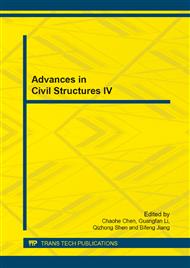p.1032
p.1037
p.1042
p.1047
p.1053
p.1059
p.1064
p.1069
p.1073
Accuracy Enhancement of Videogrammetrey for Structural Dynamic Displacement Measurement with Adaptive Filtering
Abstract:
Displacement is a good descriptor of the structural behavior and safety status. However, measuring displacement of structures under dynamic excitations is still a challenging task. Videogrammetry shows great potential for dynamic displacement measurement, benefiting from its non-contact and long-distance characteristics. Nevertheless, its all-weather performance has to be fully evaluated before gaining wide applications. This study therefore carried out an investigation into the environmental effects of the all-weather videogrammetry for structural dynamic displacement monitoring. First, long-term outdoor dynamic displacement monitoring tests were carried out. Virtual structural displacement was generated by a motion simulation device and monitored by a commercialized industrial digital camera. The adaptive filter was then employed to filter out noises, which had the primary input of the major displacement component and the reference input of the minor displacement component. The results show that the adaptive filter is well capable of filtering out noises and the measurement accuracy of videogrammetry is significantly enhanced.
Info:
Periodical:
Pages:
1053-1058
Citation:
Online since:
July 2014
Authors:
Price:
Сopyright:
© 2014 Trans Tech Publications Ltd. All Rights Reserved
Share:
Citation:


